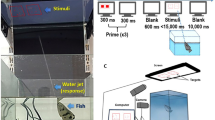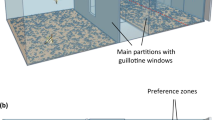Abstract
The ability to discriminate between sets that differ in the number of elements can be useful in different contexts and may have survival and fitness consequences. As such, numerical/quantity discrimination has been demonstrated in a diversity of animal species. In the laboratory, this ability has been analyzed, for example, using binary choice tests. Furthermore, when the different number of items first presented to the subjects are subsequently obscured, i.e., are not visible at the moment of making a choice, the task requires memory for the size of the sets. In previous work, angelfish (Pterophyllum scalare) have been found to be able to discriminate shoals differing in the number of shoal members both in the small (less than 4) and the large (4 or more) number range, and they were able to perform well even when a short memory retention interval (2–15 s) was imposed. In the current study, we increased the retention interval to 30 s during which the shoals to choose between were obscured, and investigated whether angelfish could show preference for the larger shoal they saw before this interval. Subjects were faced with a discrimination between numerically small shoals (≤4 fish) and also between numerically large (≥4 fish) shoals of conspecifics. We found angelfish not to be able to remember the location of larger versus smaller shoals in the small number range, but to exhibit significant memory for the larger shoal in the large number range as long as the ratio between these shoals was at least 2:1. These results, together with prior findings, suggest the existence of two separate quantity estimation systems, the object file system for small number of items that does not work with the longer retention interval and the analogue magnitude system for larger number of items that does.



Similar content being viewed by others
References
Abramson JZ, Hernández-Lloreda V, Call J, Colmenares F (2011) Relative quantity judgments in South American sea lions (Otaria flavescens). Anim Cognit 14:695–706
Agrillo C, Dadda M, Bisazza A (2007) Quantity discrimination in female mosquitofish. Anim Cognit 10:63–70
Agrillo C, Dadda M, Serena G, Bisazza A (2008) Do fish count? spontaneous discrimination of quantity in female mosquitofish. Anim Cognit 11:495–503
Agrillo C, Piffer L, Bisazza A (2010) Large number discrimination by mosquitofish. PLoS ONE 5:e15232. doi:10.1371/journal.pone.0015232
Agrillo C, Piffer L, Bisazza A, Butterworth B (2012) Evidence for two numerical systems that are similar in humans and guppies. PLoS ONE 7:e31923. doi:10.1371/journal.pone.0031923
Agrillo C, Miletto Petrazzini ME, Bisazza A (2014) Numerical acuity of fish is improved in the presence of moving targets, but only in the subitizing range. Anim Cognit 17:307–316
Armstrong N, Garland A, Burns KC (2012) Memory for multiple cache locations and prey quantities in a food-hoarding songbird. Front Psychol 3:584. doi:10.3389/fpsyg.2012.00584
Baker JM, Morath J, Rodzon KS, Jordan KE (2012) A shared system of representation governing quantity discrimination in canids. Front Psychol 3:387. doi:10.3389/fpsyg.2012.00387
Bánszegi O, Urrutia A, Szenczi P, Hudson R (2016) More or less: spontaneous quantity discrimination in the domestic cat. Anim Cognit 19:879–888
Barnard AM, Hughes KD, Gerhardt RR, JrL DiVincenti, Bovee JM, Cantlon JF (2013) Inherently analog quantity representations in olive baboons (Papio anubis). Front Psychol 4:253. doi:10.3389/fpsyg.2013.00253
Benson-Amram S, Heinen VK, Dryer SL, Holekamp KE (2011) Numerical assessment and individual call discrimination by wild spotted hyaenas, Crocuta crocuta. Anim Behav 82:743–752
Beran MJ, Beran MM (2004) Chimpanzees remember the results of one-by-one addition of food items to sets over extended time periods. Psychol Sci 15:94–99
Bogale BA, Aoyama M, Sugita S (2014) Spontaneous discrimination of food quantities in the jungle crow, Corvus macrorhynchos. Anim Behav 94:73–78
Cantlon JF, Brannon EM (2006) Shared system for ordering small and large numbers in monkeys and humans. Psychol Sci 17:401–406
Cantlon JF, Brannon EM (2007) Basic math in monkeys and college students. PLoS Biol 5:2912–2919
Cordes S, Brannon EM (2009a) Crossing the divide: infants discriminate small from large numerosities. Dev Psychol 45:1583–1594
Cordes S, Brannon EM (2009b) The relative salience of discrete and continuous quantity in young infants. Dev Sci 12:453–463
Cox L, Montrose VT (2016) Quantity discrimination in domestic rats, Rattus norvegicus. Animals 6:46. doi:10.3390/ani6080046
Evans TA, Beran MJ, Harris EH, Rice DF (2009) Quantity judgments of sequentially presented food items by capuchin monkeys (Cebus apella). Anim Cognit 12:97–105
Feigenson L, Carey S, Hauser MD (2002a) The representations underlying infants’ choice of more: object files versus analog magnitudes. Psychol Sci 13:150–156
Feigenson L, Carey S, Spelke ES (2002b) Infants’ discrimination of number vs. continuous extent. Cognit Psychol 44:33–66
Feigenson L, Dehaene S, Spelke ES (2004) Core systems of number. Trends Cognit Sci 8:307–314
Forsaktar MN, Nematollahi MA, Bisazza A (2016) Quantity discrimination in parental fish: female convict cichlid discriminate fry shoals of different sizes. Anim Cognit 19:959–964
Frommen JG, Hiermes M, Bakker TCM (2009) Disentangling the effects of group size and density on shoaling decisions of three-spined sticklebacks (Gasterosteus aculeatus). Behav Ecol Sociobiol 63:1141–1148
Garland A, Low J, Burns KC (2012) Large quantity discrimination by North Island robins (Petroica longipes). Anim Cognit 15:1129–1140
Gebuis T, Cohen Kadosh R, Gevers W (2016) Sensory-integration system rather than approximate number system underlies numerosity processing: a critical review. Acta Psychol 171:17–35
Gómez-Laplaza LM, Gerlai R (2011a) Can angelfish (Pterophyllum scalare) count? Discrimination between different shoal sizes follows Weber’s law. Anim Cognit 14:1–9
Gómez-Laplaza LM, Gerlai R (2011b) Spontaneous discrimination of small quantities: shoaling preferences in angelfish (Pterophyllum scalare). Anim Cognit 14:565–574
Gómez-Laplaza LM, Gerlai R (2012) Activity counts: the effect of swimming activity on quantity discrimination in fish. Front Psychology 3:484. doi:10.3389/fpsyg.2012.00484
Gómez-Laplaza LM, Gerlai R (2013a) Quantification abilities in angelfish (Pterophyllum scalare): the influence of continuous variables. Anim Cognit 16:373–383
Gómez-Laplaza LM, Gerlai R (2013b) The role of body surface area in quantity discrimination in angelfish (Pterophyllum scalare). PLoS ONE 8:e83880. doi:10.1371/journal.pone.0083880
Gómez-Laplaza LM, Gerlai R (2015) Angelfish (Pterophyllum scalare) discriminate between small quantities: a role of memory. J Comp Psychol 129:78–83
Gómez-Laplaza LM, Gerlai R (2016a) Discrimination of large quantities: Weber’s law and short-term memory in angelfish (Pterophyllum scalare). Anim Behav 112:29–37
Gómez-Laplaza LM, Gerlai R (2016b) Short-term memory effects on crossing the boundary: discrimination between large and small quantities in angelfish (Pterophyllum scalare). PLoS ONE 11:e0162923. doi:10.1371/journal.pone.0162923
Hager MC, Helfman GS (1991) Safety in numbers: shoal size choice by minnows under predatory threat. Behav Ecol Sociobiol 29:271–276
Hanus D, Call J (2007) Discrete quantity judgments in the great apes (Pan paniscus, Pan troglodytes, Gorilla gorilla, Pongo pygmaeus): the effect of presenting whole sets versus item-by-item. J Comp Psychol 121:241–249
Hauser MD, Carey S, Hauser LB (2000) Spontaneous number representation in semi-free ranging rhesus monkeys. Proc R Soc Lond B 267:829–833
Holm SA (1979) A simple sequentially rejective multiple test procedure. Scand J Stat 6:65–70
Hunt S, Low J, Burns KC (2008) Adaptive numerical competency in a food-hoarding songbird. Proc R Soc Lond B 275:2373–2379
Ioannou CC, Tosh CR, Neville L, Krause J (2008) The confusion effect—from neural networks to reduced predation risk. Behav Ecol 19:126–130
Kelly EM (2016) Counting on your friends: the role of social environment on quantity discrimination. Behav Proc 128:9–16
Krusche P, Uller C, Dicke U (2010) Quantity discrimination in salamanders. J Exp Biol 213:1822–1828
Landeau L, Terborgh J (1986) Oddity and the ‘confusion effect’ in predation. Anim Behav 34:1372–1380
Lemaître J-F, Ramm SA, Hurst JL, Stockley P (2011) Social cues of sperm competition influence accessory reproductive gland size in a promiscuous mammal. Proc R Soc Lond B 278:1171–1176
Lucon-Xiccato T, Miletto Petrazzini ME, Agrillo C, Bisazza A (2015) Guppies discriminate between two quantities of food items but prioritize item size over total amount. Anim Behav 107:183–191
Mahamane S, Grunig KL, Baker J, Young JK, Jordan KE (2014) Memory-based quantity discrimination in coyotes (Canis latrans). Anim Behav Cogn 1:341–351
Panteleeva S, Reznikova Z, Vygonyailova O (2013) Quantity judgments in the context of risk/reward decision making in striped field mice: first “count”, then hunt. Front Psychol 4:53. doi:10.3389/fpsyg.2013.00053
Potrich D, Sovrano VA, Stancher G, Vallortigara G (2015) Quantity discrimination by zebrafish (Danio rerio). J Comp Psychol 129:388–393
Praetorius W (1932) How the “king” lives at home. Aquarium 1(119–120):141
Reznikova Z, Ryabko B (2011) Numerical competence in animals, with an insight from ants. Behaviour 148:405–434
Rugani R, Fontanari L, Simoni E, Regolin L, Vallortigara G (2009) Arithmetic in newborn chicks. Proc R Soc Lond B 276:2451–2460
Stancher G, Sovrano VA, Potrich D, Vallortigara G (2013) Discrimination of small quantities by fish (redtail splitfin, Xenotoca eiseni). Anim Cognit 16:307–312
Stancher G, Rugani R, Regolin L, Vallortigara G (2015) Numerical discrimination by frogs (Bombina orientalis). Anim Cognit 18:219–229
Tornick JK, Callahan ES, Gibson BM (2015) An investigation of quantity discrimination in Clark’s nutcrackers (Nucifraga columbiana). J Comp Psychol 129:17–25
Ujfalussy DJ, Miklósi A, Bugnyar T, Kotrschal K (2014) Role of mental representations in quantity judgments by jackdaws (Corvus monedula). J Comp Psychol 128:11–20
Uller C (2008) Developmental and evolutionary considerations on numerical cognition. J Evol Psychol 6:1–28
Uller C, Lewis J (2009) Horses (Equus caballus) select the greater of two quantities in small numerical contrasts. Anim Cognit 12:733–738
Utrata E, Virányi Z, Range F (2012) Quantity discrimination in wolves (Canis lupus). Front Psychol 3:505. doi:10.3389/fpsyg.2012.00505
Funding
This research was supported by grant PSI2013-40768-P from the Ministerio de Economía y Competitividad (Spain) to LMG-L and an NSERC (Canada) Discovery grant to RG.
Author information
Authors and Affiliations
Corresponding author
Ethics declarations
Conflict of interest
The authors declare that they have no conflict of interest.
Ethics approval
The experiments described here comply with the current law of the country (Spain) in which they were performed, and were approved by the Committee on the Ethics of Animal Experiments of the University of Oviedo (permit number: 13-INV-2010).
Rights and permissions
About this article
Cite this article
Gómez-Laplaza, L.M., Caicoya, Á.L. & Gerlai, R. Quantity discrimination in angelfish (Pterophyllum scalare) is maintained after a 30-s retention interval in the large but not in the small number range. Anim Cogn 20, 829–840 (2017). https://doi.org/10.1007/s10071-017-1104-8
Received:
Revised:
Accepted:
Published:
Issue Date:
DOI: https://doi.org/10.1007/s10071-017-1104-8




